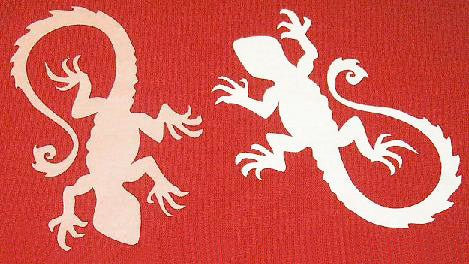With so many different brands and products out there, choosing the right white plastisol can be overwhelming.
We have established 6 main factors that should be considered when choosing a white ink:
1. Bleed Resistance - are you printing cotton/polyester blended or 100% polyester tees? If so, you will need to be aware of the important ink characteristic known as “bleed resistance”. The term “bleed” is used to describe the dye from the shirt migrating into the ink that you have printed. To avoid “bleed” or “dye migration”, use a white plastisol that is formulated to block the dye from bleeding into the plastisol. These inks are often referred to as “low bleed” or “poly” inks.
See figure 1A for a print where the dye from the shirt migrated into the plastisol ink

2. Cost - white ink is the most commonly used color in screen printing. If you are doing a good amount of printing, chances are, you’ll be using up quite a bit of white ink. Choose an ink that matches your budget, but try to do so without compromising on quality. Buying in bulk is a great way to save.. Consider purchasing white ink in 5 gallon pails to save some cash.
3. Printability - we refer to the “ease of use” of an ink as printability. If your ink is next to impossible to push through a screen, or constantly clogging, we would consider this poor printability. Now, there are some other factors that will play in, such as mesh count and ambient tempurature, but for the most part, your white ink shouldn’t be super thick and stiff. For example, if you are printing through a 160 mesh screen, and your shop temperature is up around 80 degrees fahrenheit, you should be able to push the ink through the screen with a couple passes, and clear it completely.
4. Opacity / Coverage - Opacity refers to how opaque the ink is, and how well it will cover up the color of the shirt. The industry standard for white ink on dark color tees is to “print / flash / print”. In other words, the first layer of white, or “underbase” is layed down, cured, then printed again with the top layer of white. Printing 2 layers of white achieves the best coverage on dark colors.
5. Flash Point - this is the temperature at which the ink cures. White inks with high flash points will need to be cured at hotter temperatures and therefor require more time under the flash than white inks with low flash points. Inks that cure at lower temperatures can be useful when printing garments that scorch or melt at higher temperatures.
6. Brightness - The brightness of a white ink refers to how bright the finished print is on the shirt after it has been cured. Some white inks are brighter than others.
Our best selling white inks:
Cotton White Plastisol
Great for 100% cotton shirts. Low cost, no bleed resistance.
Here is a link to our best selling white for cotton tees:
7038 BLAZE COTTON WHITE
50/50 White Plastisol
Great for cotton / poly blends no less than 50% cotton
Here is a link to our best selling white ink for 50/50 cotton poly tees:
7014 LEGACY 50/50 WHITE
Poly White Plastisol
Use Poly White on 100% polyester garments.
Here is a link to our best selling white ink for 100% polyester tees:

